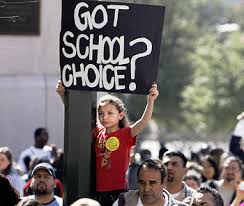Why aren’t Republicans trying harder to reach school-choice voters?

By Michael Brickman
Republicans are still gleeful after their 2014 victories in the U.S. Senate and statehouses across the nation. They should be, but they should also take heed.
A CNN exit poll shows that despite historic wins, Republicans still lost with women voters, voters under forty, non-white voters, low-income voters, and more.
GOT SCHOOL CHOICE: There are 116,000 children in the U.S. that attend private schools with the help of taxpayer-funded vouchers.
On top of it, as many commentators have noted, the U.S. Senate map is much tougher for Republicans in 2016 than it was in 2014, and Democratic enthusiasm and turnout are sure to be substantially higher in a presidential election year than they were on Nov. 4.
To win in two years, Republicans simply must develop new coalitions of voters. As Woody Allen said, “Showing up is 80 percent of life,” and the Republican Party is beginning to do just that by starting conversations with traditionally Democratic voters. The efforts have yielded some results, too, with positive signs in Florida, Texas, Colorado, and elsewhere.
Conservatives surely need to continue the getting-to-know-you phase, but they must then move the conversation with persuadable voters to concrete policy proposals that can help reduce poverty and open paths to the American Dream.
As I’ve argued before, one obvious policy on which conservatives already have a degree of credibility is school choice. While conservatives are generally very supportive of these policies (rural Republican state legislators are sometimes an exception), they have not seemed to fully grasp their potential as a way to build new Republican coalitions.
Consider the following:
- 5.2 million children attend private schools.
- This includes 116,000 who do so with the help of taxpayer-funded vouchers and another 192,000 who attend with the help of a tax-credit scholarship.
- Of those students in private school-choice programs (many of which are targeted to students with special needs), 86,714 are in the key swing state of Florida, 60,619 are in North Carolina, more than 31,000 are in Ohio, and 26,618 are in Wisconsin.
- Only 761 students are so far enrolled in new education savings account programs in Florida and Arizona, but they have very compelling stories to tell.
- Another 2.2 million children are homeschooled.
- 2.6 million attend charter schools, but another 1 million are on waiting lists.
- Roughly 8 million attend a more traditional public school they were able to choose, including 2.8 million who attend magnet schools.
- As school choice becomes more granular, students will be able to take advantage of new course access laws. Last year, 2.2 million students took advantage of an early version of course-based school choice in the form of Advanced Placement tests. Students are also estimated to have enrolled in another roughly 2 million online and other distance-education courses.
Of course, the vast majority of these K–12 students don’t vote, but their parents, grandparents, guardians and members of extended support networks certainly do.
Some Democrats (especially those in cities) express some support for some of these options some of the time. However, when push comes to shove and they are forced to either stand with families who want greater educational choice or with the public unions encouraging them to reduce it, they all too often choose the latter. After all, the National Education Association says it spent between $34 million and $40 million in the midterm elections (and that number is almost certainly higher).
When it comes to securing a brighter future for the children of those who are struggling — or who simply want the freedom to chart their own educational path — there is simply nothing more attractive than the promise of a better education. Republicans already have made this issue part of their agenda and, though they certainly cannot expect to attract many new voters with a single issue alone, their continued fight for these policies will help. But in order to win, they must emphatically make the case to voters that one side is fighting for disadvantaged children, and one side is fighting for well-funded special-interest groups.







